When using UAVs for event coverage, you'll need to secure thorough insurance that meets seven essential requirements. These include adequate liability coverage limits, equipment protection, third-party property damage insurance, and personal injury coverage. You'll also need to address venue-specific insurance requirements, guarantee proper operator certification and training, and comply with local regulations. It's vital to understand coverage limits, exclusions, and deductibles for each aspect. By addressing these key areas, you'll minimize risks and protect yourself, your equipment, and event attendees. Exploring each requirement in detail will help you navigate the complexities of UAV insurance for events.
Key Takeaways
- Comprehensive liability coverage with adequate limits for spectator injuries and property damage.
- Personal injury protection addressing privacy invasion claims and potential legal defense costs.
- Equipment and drone coverage for damage, theft, or loss during transport and operation.
- Third-party property damage insurance with sufficient limits for potential venue or client equipment damage.
- Operator certification compliance and adherence to local, state, and federal UAV regulations.
Liability Coverage Limits
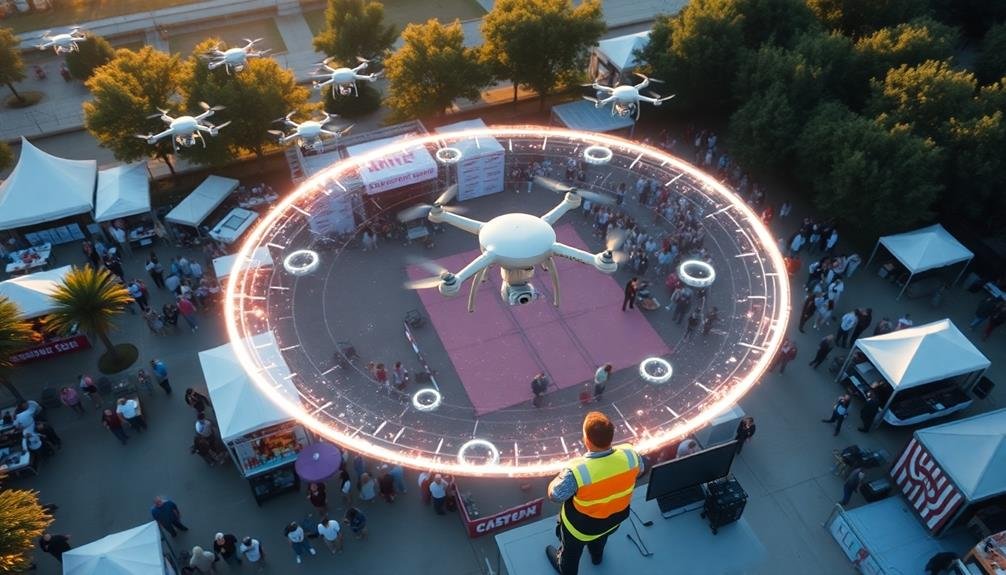
When it comes to liability coverage limits for event UAV insurance, you'll need to contemplate several factors.
First, consider the scale of your event and the potential risks involved. Larger events with more attendees typically require higher coverage limits to protect against accidents or injuries.
You'll want to assess the value of the property where you're operating the UAV. Higher-value venues may necessitate increased liability coverage.
Don't forget to account for any expensive equipment or structures that could be damaged during flight operations.
Your coverage limits should also align with local regulations and venue requirements. Some locations may have specific minimum coverage amounts for UAV operations. It's essential to check these beforehand to guarantee compliance.
Consider your client's expectations and contractual obligations. They may require certain coverage limits as part of your agreement.
Industry standards can vary, but typical liability coverage for event UAV operations ranges from $1 million to $5 million.
Lastly, evaluate your risk tolerance and financial situation. Higher coverage limits offer more protection but come with increased premiums.
Strike a balance between adequate coverage and affordability to safeguard your business without breaking the bank.
Equipment Protection
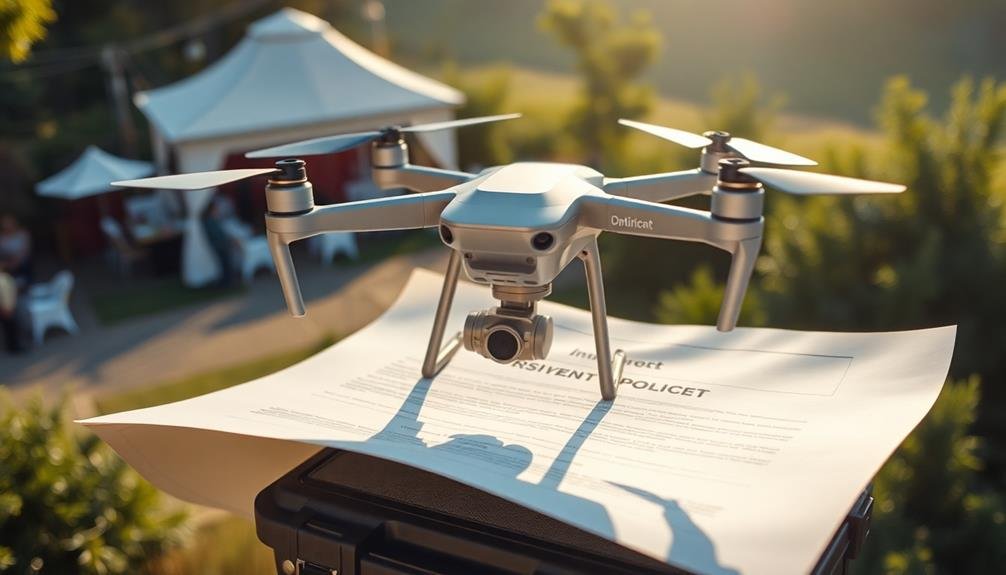
When considering equipment protection for your event UAV coverage, you'll need to ascertain your policy includes drone and accessory coverage.
You're also responsible for addressing liability for equipment damage, which can occur during transport or operation.
Factor in replacement cost considerations to guarantee you're adequately covered if your drone or related equipment needs to be repaired or replaced.
Drone and Accessory Coverage
Nearly all extensive drone insurance policies include equipment protection for your UAV and its accessories. This coverage safeguards your investment against damage, theft, or loss. It's vital to understand what's covered and what's not.
Your policy should protect the drone itself, along with essential accessories like batteries, controllers, and cameras. Some insurers offer coverage for ground control stations and transportation cases. Be sure to itemize your equipment and keep records of purchase dates and values.
Here's a breakdown of typical drone and accessory coverage:
| Item | Typically Covered? | Notes |
|---|---|---|
| Drone Body | Yes | Main aircraft structure |
| Propellers | Yes | Often with limitations |
| Batteries | Yes | Usually limited quantity |
| Controller | Yes | Primary flight control device |
| Camera/Gimbal | Often | May require additional premium |
Liability for Equipment Damage
Equipment protection goes beyond safeguarding your own gear. When operating drones at events, you're responsible for potential damage to others' property. Your insurance should cover liability for equipment damage, including:
- Venue property: Protect against accidental damage to the event space, such as walls, ceilings, or fixtures.
- Client equipment: Cover potential harm to the client's gear, like cameras, lighting, or sound systems.
- Third-party property: Guarantee coverage for damage to attendees' personal belongings or vehicles.
- Rented equipment: Include protection for any rented drones or accessories you're using.
You'll need to carefully review your policy's limits and deductibles for equipment damage liability. Don't assume your standard drone insurance covers all these scenarios. Many policies have exclusions or limitations for commercial use or specific event types.
It's vital to communicate with your insurance provider about the nature of your event work and any unique risks involved. They may recommend additional riders or specialized coverage to fully protect you from equipment damage liability.
Replacement Cost Considerations
In the blink of an eye, your expensive drone can become a heap of broken parts. That's why evaluating replacement cost coverage is vital when insuring your UAV for event work. This type of insurance guarantees you're not left out of pocket if your drone is damaged beyond repair or stolen.
When assessing replacement cost coverage, you'll need to accurately gauge your drone's current market value. Don't forget to include all accessories, such as extra batteries, cameras, and specialized equipment.
Keep in mind that technology evolves rapidly, so your policy should account for potential upgrades or newer models. You'll also want to reflect on whether your policy offers new-for-old replacement or if it factors in depreciation.
Some insurers may have waiting periods or deductibles before replacing your equipment, so read the fine print carefully. Additionally, check if your policy covers rented or borrowed equipment, as this can be essential for larger events where you might need to supplement your gear.
Lastly, verify your coverage extends to all locations where you'll be operating, including during transport. This thorough approach will help protect your investment and keep your business running smoothly.
Third-Party Property Damage Insurance
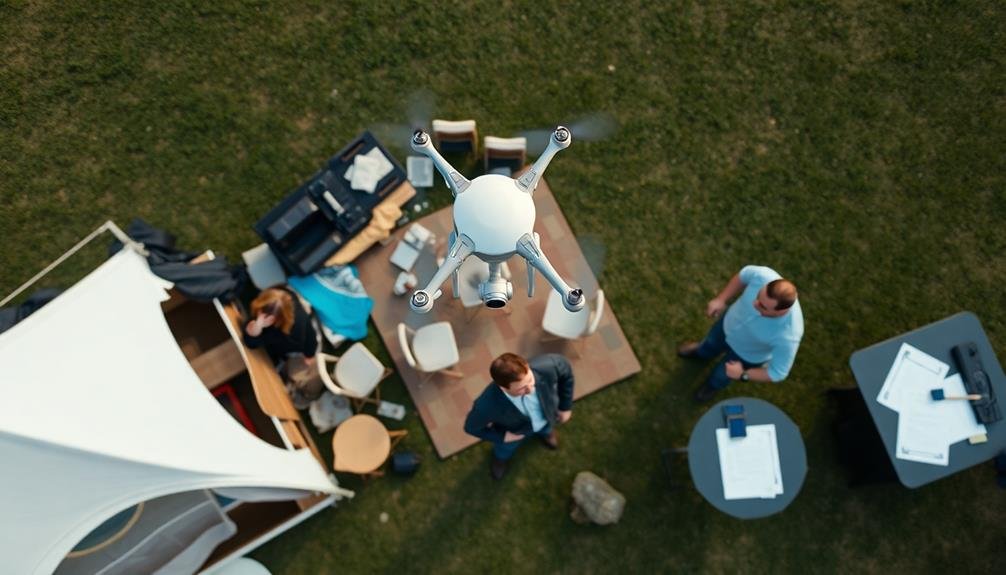
Protecting against potential mishaps, third-party property damage insurance is an essential component of UAV event coverage. This type of insurance safeguards you from financial liability if your drone causes damage to someone else's property during an event.
It's vital to understand the scope and limitations of this coverage to guarantee you're adequately protected.
When selecting third-party property damage insurance for your UAV event coverage, consider these key factors:
- Coverage limits: Confirm the policy provides sufficient coverage for potential damages, taking into account the value of surrounding property at your event location.
- Deductible amount: Choose a deductible that balances affordability with your ability to pay out-of-pocket in case of an incident.
- Exclusions: Carefully review policy exclusions to understand what types of damages aren't covered.
- Geographical restrictions: Confirm that the policy covers the specific location where your event will take place.
Personal Injury Coverage
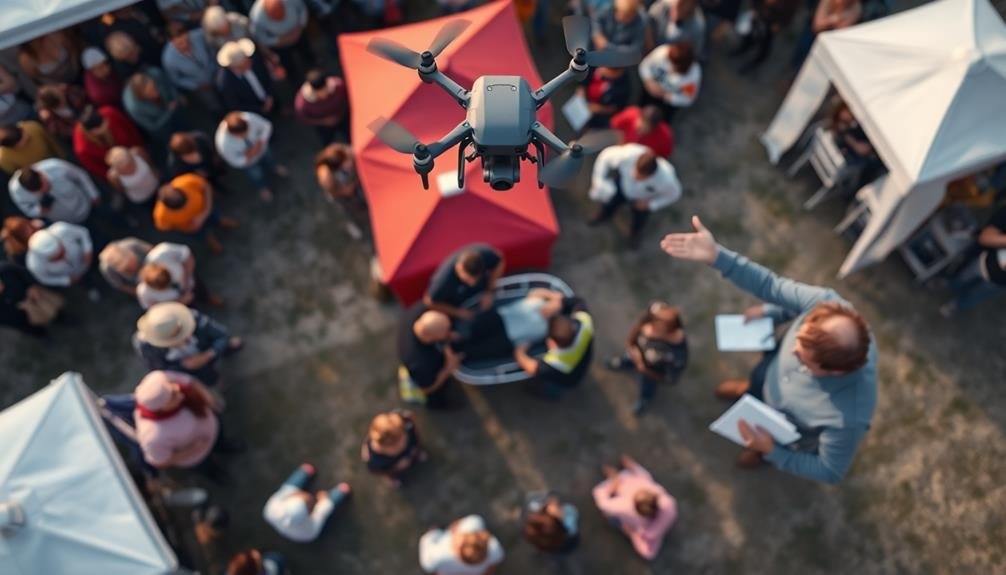
When operating a UAV at events, you'll need personal injury coverage to protect against potential accidents involving spectators.
This insurance should encompass liability for drone-related injuries and damages that may occur during your flight operations.
Additionally, you'll want to guarantee your policy covers claims related to privacy invasion, as drones equipped with cameras can inadvertently capture sensitive information or intrude on personal spaces.
Liability for Drone Accidents
Liability for drone accidents falls squarely on the operator's shoulders, making personal injury coverage vital for event UAV pilots. You'll need to protect yourself against potential claims arising from accidents or mishaps during your event coverage. This insurance typically covers bodily injury, property damage, and legal defense costs if you're sued.
When considering liability coverage for drone accidents, keep these key points in mind:
- Coverage limits: Verify your policy provides adequate protection, usually starting at $1 million for most events.
- Exclusions: Understand what's not covered, such as intentional acts or flying in restricted areas.
- Additional insured: Be prepared to add event organizers or venues as additional insured parties.
- Incident reporting: Know the proper procedures for reporting accidents or incidents to your insurer.
You'll also want to maintain detailed flight logs and follow all FAA regulations to strengthen your position in case of a claim.
Spectator Injury Protection
How can you safeguard your drone business against potential spectator injuries? When operating UAVs at events, it's vital to have thorough personal injury coverage. This protection shields you from financial liability if a spectator is injured due to your drone operations.
Your insurance policy should cover medical expenses, legal fees, and potential settlements. It's important to understand the specific terms and limits of your coverage. Some policies may exclude certain types of injuries or have restrictions based on event size or location.
To guarantee adequate protection, consider the following factors:
| Coverage Type | Recommended Limit | Key Considerations |
|---|---|---|
| Bodily Injury | $1M – $5M per occurrence | Event size, location risk |
| Medical Payments | $5K – $25K per person | Quick resolution for minor injuries |
| Legal Defense | Included in policy limit | Separate limit preferable |
| Property Damage | $500K – $2M per occurrence | Potential for collateral damage |
Don't forget to review your policy regularly and adjust coverage as your business grows. You'll also need to comply with local regulations and event-specific requirements. By prioritizing spectator safety and maintaining adequate insurance, you'll protect both your business and the public.
Privacy Invasion Claims
In light of the increasing use of drones at events, privacy invasion claims have become a significant concern for UAV operators.
You'll need to ascertain your insurance policy covers personal injury claims related to privacy violations. This type of coverage protects you from lawsuits alleging invasion of privacy, libel, slander, or copyright infringement resulting from your drone operations.
When seeking insurance for privacy invasion claims, consider these key factors:
- Coverage limits: Verify your policy provides adequate protection for potential legal expenses and settlements.
- Exclusions: Carefully review any exclusions in the policy that might leave you vulnerable to certain types of privacy-related claims.
- Consent requirements: Understand if your policy mandates obtaining consent from event attendees before capturing footage.
- Data protection: Check if your insurance covers breaches of data protection laws or unauthorized use of collected information.
You should also implement best practices to minimize privacy risks, such as avoiding capturing identifiable images of individuals without consent and securely storing any collected data.
Venue-Specific Insurance Requirements
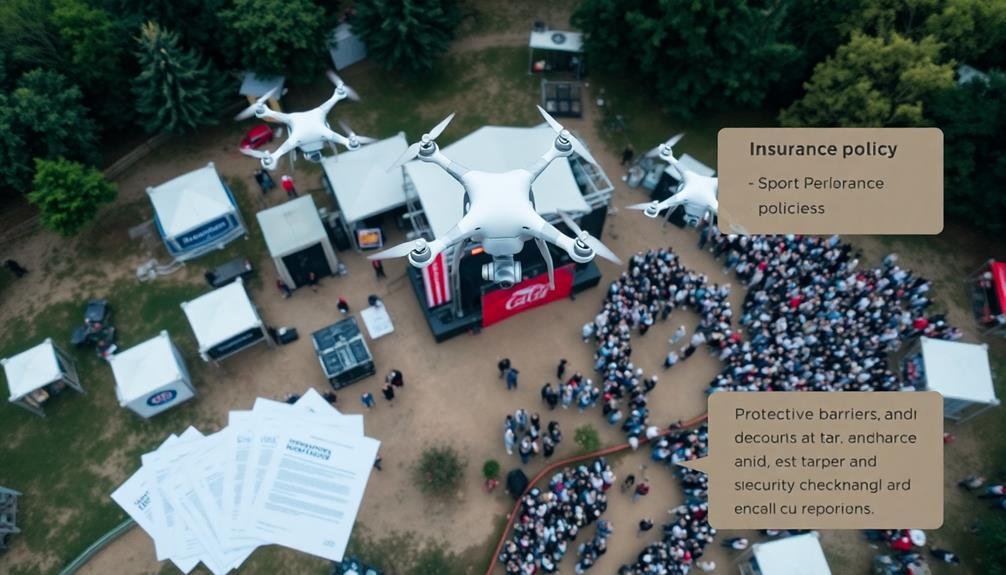
While general liability insurance is essential for UAV operators at events, many venues impose their own specific insurance requirements. You'll need to carefully review each venue's policies before accepting a job. These requirements often vary based on factors like the event type, expected attendance, and potential risks associated with drone operations.
Common venue-specific insurance requirements include:
| Requirement | Description |
|---|---|
| Higher Limits | Venues may demand coverage exceeding standard policies |
| Additional Insured | Venue often needs to be listed as an additional insured |
| Certificates | Proof of insurance must be provided before the event |
| Waivers | Specific waivers of subrogation may be required |
You'll likely encounter venues that demand higher coverage limits than your standard policy provides. In these cases, you may need to purchase additional coverage or a separate event-specific policy. Some venues might also require you to list them as an additional insured on your policy, which protects them from potential liability claims arising from your drone operations.
Always obtain and carefully review the venue's insurance requirements well in advance of the event. This allows you to secure the necessary coverage and avoid last-minute complications that could jeopardize your ability to operate at the event.
Operator Certification and Training
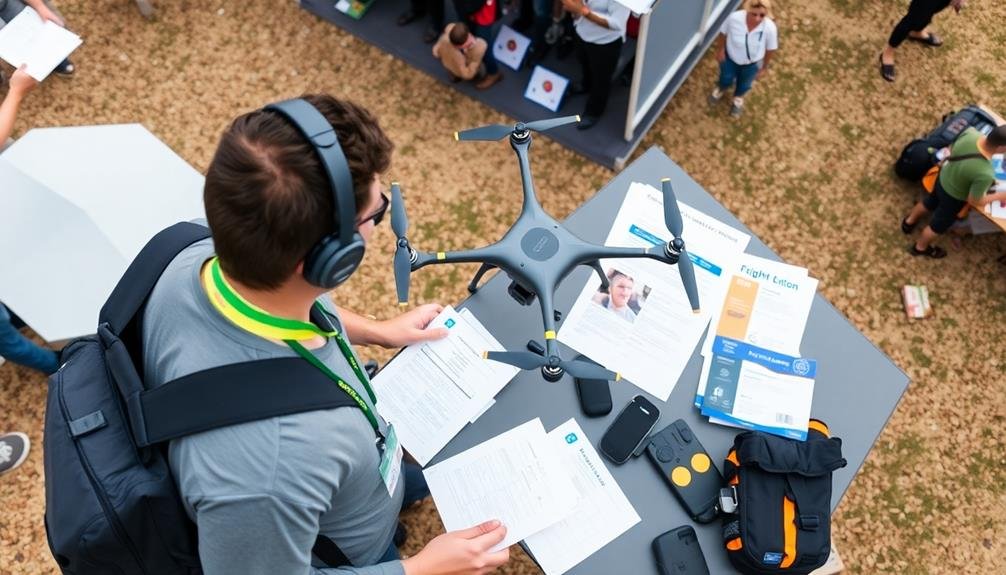
Beyond insurance requirements, you'll need to demonstrate your qualifications as a UAV operator for event coverage. Most event organizers and venues will expect you to have proper certification and training. In the United States, this typically means holding a Part 107 Remote Pilot Certificate from the FAA. However, additional qualifications may be necessary depending on the event's nature and location.
To guarantee you're fully prepared, focus on these key areas:
- Certification: Obtain and maintain your Part 107 license, and consider additional certifications specific to event photography or videography.
- Training: Invest in ongoing education to stay current with regulations, technology, and best practices in UAV operation.
- Experience: Build a portfolio showcasing your expertise in event coverage, highlighting your ability to navigate crowded spaces safely.
- Safety protocols: Develop and document detailed safety procedures for various event scenarios.
Don't underestimate the importance of soft skills, either. You'll need to communicate effectively with event organizers, venue staff, and attendees.
Being able to explain your safety measures and operational procedures clearly can help build trust and secure more opportunities for event UAV coverage.
Compliance With Local Regulations
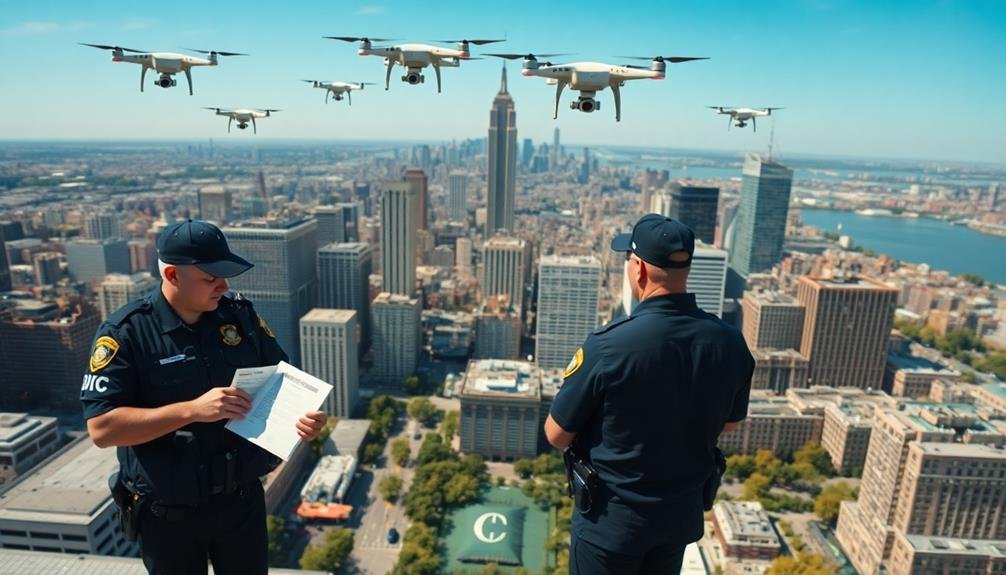
Complying with local regulations is a critical aspect of UAV event coverage that goes hand-in-hand with proper certification and training. You must research and adhere to all local, state, and federal laws governing drone operations in your event's location. This includes obtaining necessary permits, respecting airspace restrictions, and following specific guidelines for commercial drone use.
Check with the local authorities to verify you're aware of any temporary flight restrictions or special event regulations. Many cities have their own drone ordinances, which may limit where and when you can fly. You'll need to be familiar with these rules to avoid potential fines or legal issues.
Don't forget to register your drone with the FAA if required, and always carry proof of registration during operations. Be prepared to show your documentation to law enforcement or event security if asked.
Additionally, respect privacy laws and obtain necessary permissions when filming over private property or in sensitive areas.
Frequently Asked Questions
How Far in Advance Should I Secure UAV Insurance for an Event?
You should secure UAV insurance at least 2-4 weeks before your event. This allows time to compare policies, address any issues, and guarantee coverage is in place. Don't wait until the last minute to protect yourself.
Are There Any Airspace Restrictions That Could Affect My Event Coverage?
Yes, there are airspace restrictions that could affect your event coverage. You'll need to check for no-fly zones, controlled airspace, and temporary flight restrictions. Always consult local regulations and obtain necessary permissions before flying your UAV.
What Happens if Weather Conditions Prevent Planned UAV Operations During the Event?
If weather prevents your UAV operations, you'll need to adjust quickly. You can switch to ground-based filming, reschedule drone flights for better conditions, or utilize alternative coverage methods. Always have a backup plan ready.
Can I Get Insurance for Multiple UAV Operators at a Single Event?
Yes, you can typically get insurance for multiple UAV operators at a single event. You'll want to discuss this with your insurance provider to guarantee all operators are properly covered under the policy for that specific event.
How Does Insurance Coverage Differ for Indoor Versus Outdoor Event UAV Operations?
You'll find indoor and outdoor UAV operations have different insurance considerations. Indoor flights often face lower risks and may have cheaper premiums. Outdoor operations typically need more coverage due to increased hazards and regulatory requirements.
In Summary
You've now got the essential insurance requirements for event UAV coverage. Don't skimp on these vital protections. They'll safeguard your business, equipment, and clients. Remember, each event may have unique needs, so always double-check venue-specific requirements. Stay up-to-date with local regulations and maintain proper certifications. By covering all these bases, you'll be well-prepared for a successful and worry-free drone operation at your next event.
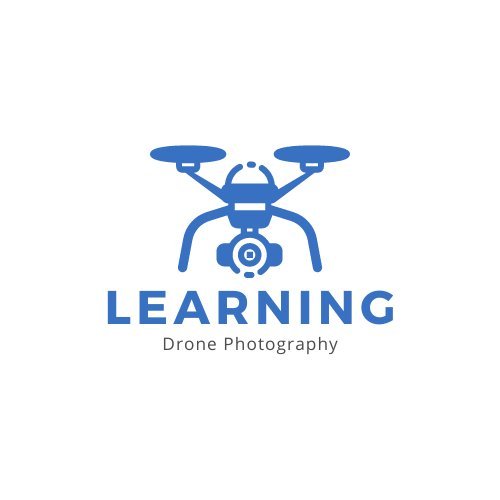
As educators and advocates for responsible drone use, we’re committed to sharing our knowledge and expertise with aspiring aerial photographers.
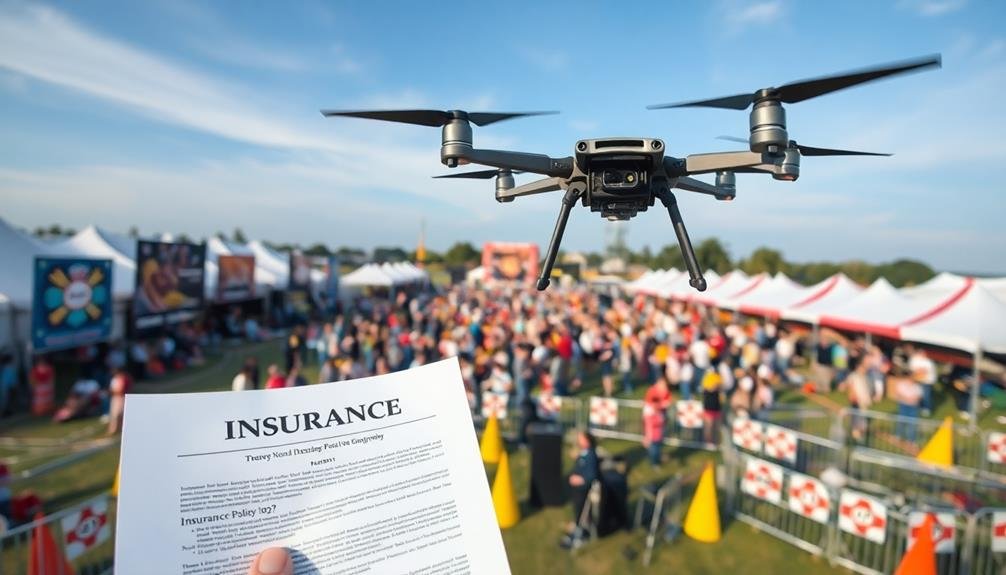
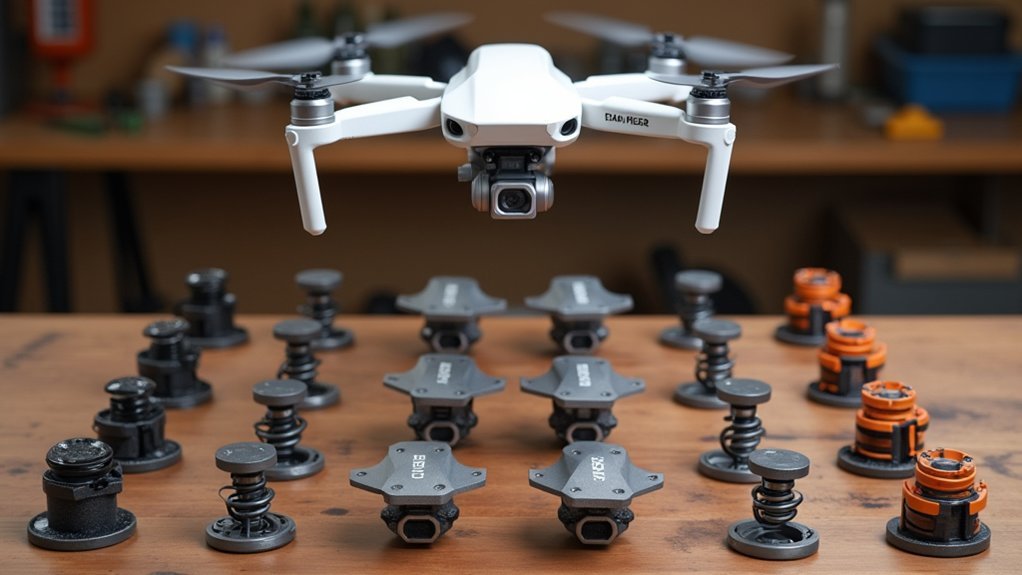
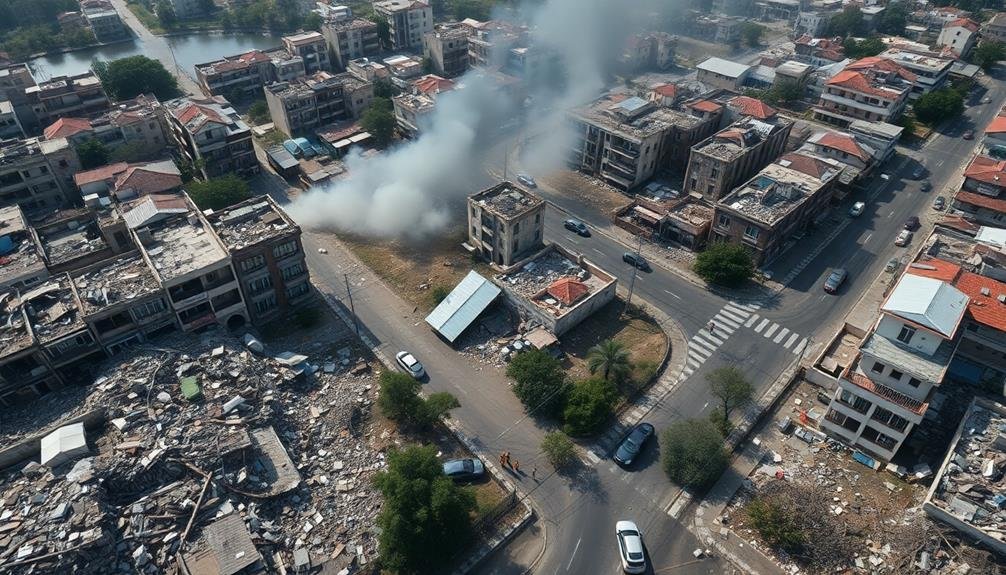
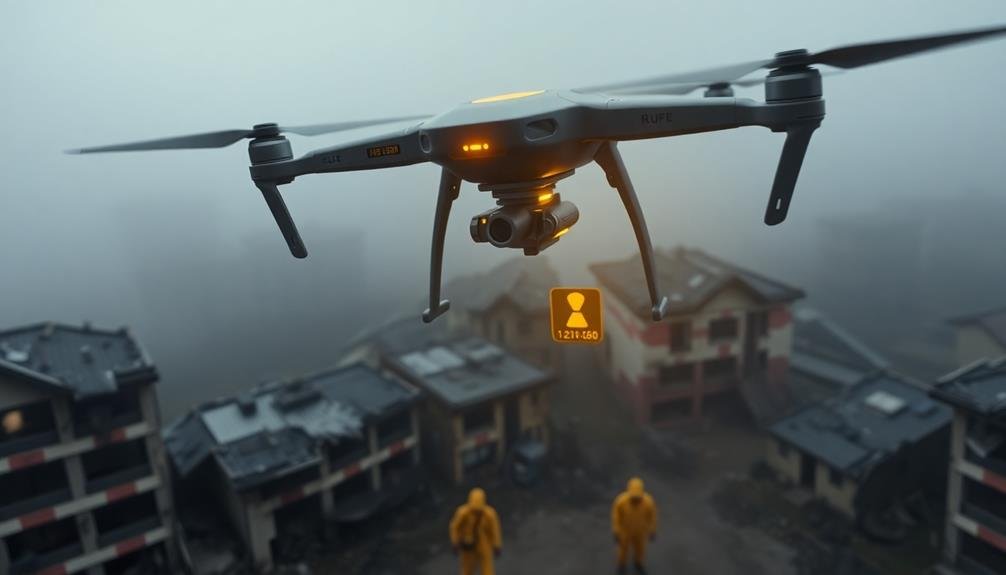
Leave a Reply